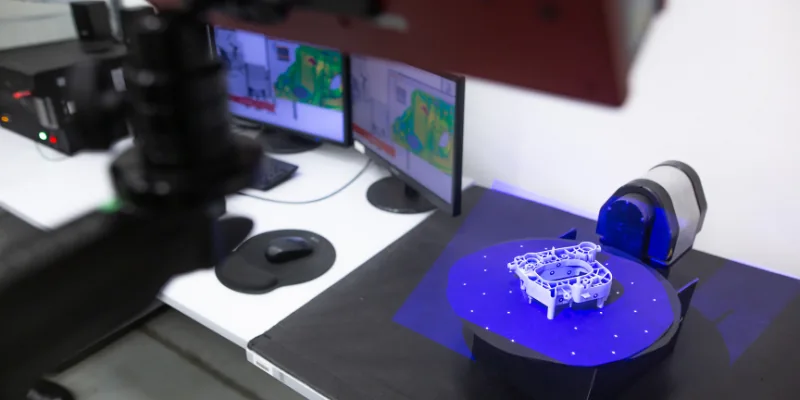3D Scanners Feel the Future in Every Scan
Published: 30 May 2025
Did you know that 3D scanners can capture millions of data points in seconds? These devices use advanced technology to scan real-world objects and turn them into digital 3D models. From industrial design to medical applications, 3D scanners are transforming how we create, analyze, and replicate objects with incredible accuracy. Let’s explore the information about 3D Scanners:
Introduction
A 3D scanner is a device that captures the shape and details of physical objects and converts them into digital 3D models. It works by using lasers, light, or cameras to scan the object’s surface, gathering data points to recreate the object in digital form. These models can be used for design, analysis, or even 3D printing.
Importance of 3D Scanner
- Accuracy: It captures precise details of physical objects, improving design and analysis.
- Efficiency: Reduces the time spent measuring and replicating objects manually.
- Innovation: Opens up new possibilities in industries like healthcare, gaming, and manufacturing.
- Customization: Allows for creating custom parts or products based on exact specifications.
- Cost-Effective: Reduces material waste and errors in the production process.

Types of 3D Scanners
- Handheld 3D Scanners: Portable scanners ideal for capturing objects on the go.
- Desktop 3D Scanners: Compact devices for scanning small to medium-sized objects with high accuracy.
- Industrial 3D Scanners: High-precision scanners used in manufacturing and large-scale applications.
- Laser 3D Scanners: Use laser beams to capture detailed measurements from objects.
- Lidar 3D Scanners: Use laser pulses to scan large environments, like landscapes or buildings.
- Structured Light 3D Scanners: Project patterns of light onto objects to capture their shape with high precision.
- Optical 3D Scanners: Capture surface details using cameras and light sensors, often used for art or design.
Applications of 3D Scanners
- Manufacturing: Used for prototyping, quality control, and reverse engineering.
- Healthcare: Helps create custom prosthetics and assists in surgical planning.
- Art and Restoration: Used to digitize and restore artwork, sculptures, and historical artifacts.
- Gaming and Virtual Reality: Scans real-world objects to create realistic 3D models for games and VR environments.
- Architecture and Construction: Aids in creating detailed models of buildings and structures for design or renovation.
- Automotive: Used for vehicle design, inspection, and part replacement.
- Aerospace: Supports precise part manufacturing and repairs for aircraft and spacecraft.
- Education: Provides hands-on learning experiences in design, engineering, and technology.
| Advantages of 3D Scanners |
|---|
|
| Disadvantages of 3D Scanners |
|---|
|
A 3D scanner is a device that captures the shape and details of objects by scanning them. It turns physical items into digital 3D models. These models can be used for design, analysis, or printing.
A 3D scanner works by using light, lasers, or cameras to capture the surface of an object. It creates a digital map of the object’s shape and details. This map is then used to form a 3D model.
Yes, many smartphones can be turned into basic 3D scanners with the help of apps. These apps use your phone’s camera to scan objects. However, they may not provide the same level of detail as professional scanners.
Not necessarily. A 3D scanner creates digital models, while a 3D printer turns those models into physical objects. If you want to make physical copies of what you scan, you’ll need both devices.
3D scanners can be very accurate, depending on the type and model. High-end scanners can capture details down to millimeters or even microns. Budget models may have lower accuracy but are still useful for many applications.
3D scanners are used in fields like design, healthcare, art restoration, and gaming. They help create accurate models for prototypes, custom prosthetics, or even historical artifacts. They’re also used in virtual reality and gaming for realistic modeling.
3D scanners range in price from around $100 for basic models to several thousand dollars for professional ones. The price depends on the scanner’s accuracy, features, and intended use. There are affordable options for beginners that offer good quality for the price.
To choose the right 3D scanner, consider factors like your budget, what you plan to scan, and how accurate you need the scan to be. Handheld scanners are portable, while desktop models offer higher precision. Do some research to find one that fits your needs.
Most 3D scanners can scan a variety of objects, but they work best with solid, non-reflective surfaces. Shiny or transparent objects can be harder to scan accurately. You may need to adjust the scanner settings or use spray for better results on certain objects.
The time it takes to scan an object depends on its size and the scanner’s type. Small objects might only take a few minutes, while larger objects could take longer. Higher-quality scanners can capture more detail in less time, but it’s always good to plan for extra time when scanning complex items.
Conclusion
So guys, in this article, we’ve covered 3D Scanners in detail. By now, you probably see how useful they can be for everything from design to gaming. If you’re looking for a beginner-friendly option, I’d personally recommend a compact, budget-friendly scanner like the Creality CR-Scan, it’s great for learning the basics. Are you excited to try 3D scanning? Let me know your thoughts in the comments, and don’t forget to share this with anyone who might find it useful!

- Be Respectful
- Stay Relevant
- Stay Positive
- True Feedback
- Encourage Discussion
- Avoid Spamming
- No Fake News
- Don't Copy-Paste
- No Personal Attacks

- Be Respectful
- Stay Relevant
- Stay Positive
- True Feedback
- Encourage Discussion
- Avoid Spamming
- No Fake News
- Don't Copy-Paste
- No Personal Attacks
